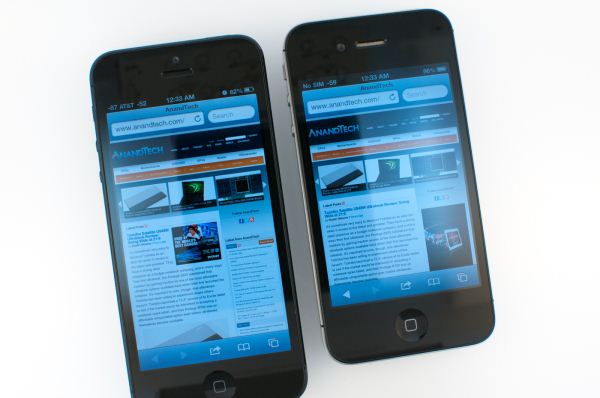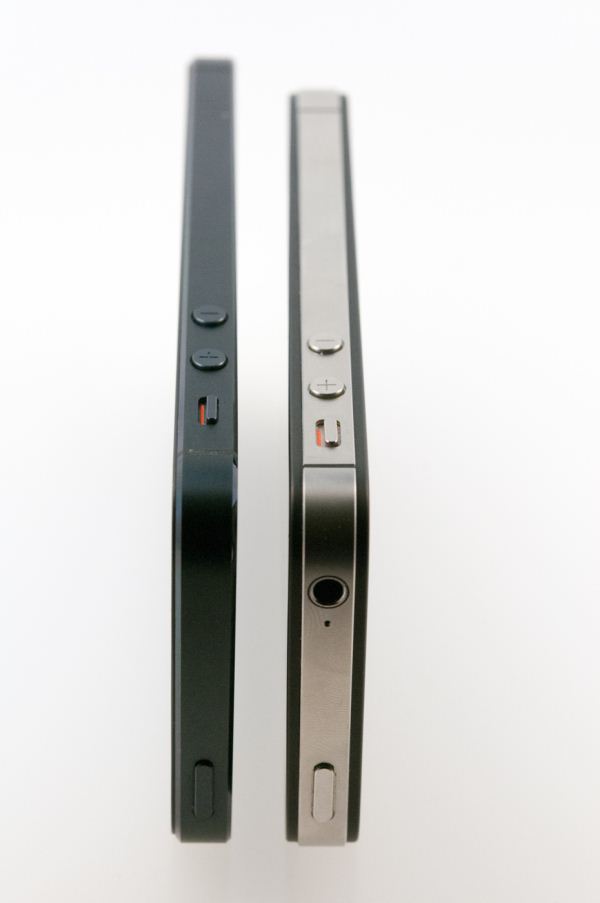The iPhone 5 Review
by Anand Lal Shimpi, Brian Klug & Vivek Gowri on October 16, 2012 11:33 AM EST- Posted in
- Smartphones
- Apple
- Mobile
- iPhone 5
The last significant redesign of the iPhone platform came in 2010 with the iPhone 4. It was an update that literally touched all aspects of the device, from SoC to display to baseband and of course, chassis. Last month’s launch of the iPhone 5 is no different in magnitude. The sixth generation iPhone makes some of the biggest changes to the platform since its introduction in 2007.
Visually the device begins by evolving the design language of the iPhone 4/4S chassis. From the launch of the iPhone 4 it was quite obvious that Apple had picked a design it was quite proud of. Thus it’s not too surprising that, from a distance, the iPhone 5 resembles the previous two iPhone models. We’ll get into material differences shortly, but what make the iPhone 5 design such a radical departure is its larger display.
All previous iPhones have maintained the same 3.5-inch, 3:2 aspect ratio display. With the rest of the world quickly moving to much larger displays, and with 16:9 the clear aspect ratio of choice, when faced with the decision of modernizing the iPhone platform the choice was obvious.
The iPhone 5 embraces a taller, 4-inch, 16:9 1136 x 640 display opting to lengthen the device instead of increasing its area in both dimensions. The result is a device that is distinctly an iPhone, albeit a modern one. The taller display doesn’t do much to make desktop web pages any easier to read as a result of the width staying the same. Those longing for an HTC One X or Galaxy S 3 sized device running iOS are out of luck. Reading emails and typing are both improved though as there’s now more room for lists and the keyboard no longer occupies as much of the display. The taller device can be more awkward to use if you have smaller hands, but the added screen real estate is honestly worth it. Once you get used to the iPhone 5’s display, going back to the older models is tough.
The taller chassis went on a diet as well. The iPhone 5 is now considerably thinner and lighter than its predecessor, which is yet another factor that contributes to it feeling more modern.
Internally the device changes are just as significant, if not more, than those on the outside. The iPhone 5 includes LTE support, which in areas where LTE networks are deployed can be enough reason alone to warrant an upgrade.
The iPhone 5 also includes a brand new SoC from Apple: the A6. For the first time since the introduction of the iPad, Apple has introduced a major branded SoC on an iPhone first. The iPhone 4 used the A4 after it debuted on the iPad, and the 4S picked up the A5 months after the iPad 2 launched with it. The A6 however arrives first on the iPhone 5, and with it comes two of Apple’s first, custom designed CPU cores. We’ve always known Apple as a vertically integrated device and software vendor, but getting into CPU design takes that to a new level.
| Physical Comparison | ||||
| Apple iPhone 4S | Samsung Galaxy S 3 (USA) | HTC One S | Apple iPhone 5 | |
| Height | 115.2 mm (4.5") | 136.6 mm (5.38" ) | 130.9 mm (5.15" ) | 123.8 mm (4.87") |
| Width | 58.6 mm (2.31") | 70.6 mm (2.78") | 65 mm (2.56") | 58.6 mm (2.31") |
| Depth | 9.3 mm ( 0.37") | 8.6 mm (0.34") | 7.8 mm (0.31") | 7.6 mm (0.30") |
| Weight | 140 g (4.9 oz) | 133g (4.7 oz) | 119.5g (4.21 oz) | 112 g (3.95 oz) |
| CPU | Apple A5 @ ~800MHz Dual Core Cortex A9 | 1.5 GHz MSM8960 Dual Core Krait | 1.5 GHz MSM8260A Dual Core Krait | 1.3 GHz Apple A6 (Dual Core Apple Swift) |
| GPU | PowerVR SGX 543MP2 | Adreno 225 | Adreno 225 | PowerVR SGX 543MP3 |
| RAM | 512MB LPDDR2-800 | 2 GB LPDDR2 | 1 GB LPDDR2 | 1 GB LPDDR2 |
| NAND | 16GB, 32GB or 64GB integrated | 16/32 GB NAND with up to 64 GB microSDXC | 16 GB NAND | 16, 32, or 64 GB integrated |
| Camera | 8 MP with LED Flash + Front Facing Camera | 8 MP with LED Flash + 1.9 MP front facing | 8 MP with LED Flash + VGA front facing | 8 MP with LED Flash + 1.2MP front facing |
| Screen | 3.5" 960 x 640 LED backlit LCD | 4.8" 1280x720 HD SAMOLED | 4.3" 960x540 Super AMOLED | 4" 1136 x 640 LED backlit LCD |
| Battery | Internal 5.3 Whr | Removable 7.98 Whr | Removable 6.1 Whr | Internal 5.45 Whr |
There’s a lot to talk about when it comes to the new iPhone. Whether it is understanding the architecture of the A6 SoC or investigating the improved low light performance of the iPhone 5’s rear facing camera, we’ve got it here in what is easily our most in-depth iPhone review to date. Let’s get started.












276 Comments
View All Comments
Zink - Wednesday, October 17, 2012 - link
That's would be light enough to float.manders2600 - Wednesday, October 17, 2012 - link
It would be really nice to see some of these benchmarks next to an Android device running Jellybean.From my personal experience with the Galaxy Nexus, all of the benchmarks run in this article improve dramatically (many by more than 50%) with that OS version.
I'm really curious to see what a comparison between the performance of an S4 (Krait) and an A6 would be in that situation, since so much of the CPU tests are impacted by OS.
manders2600 - Wednesday, October 17, 2012 - link
But great read, though!. . . sorry, forgot to include that.
Tremendous research went into this, and it is well appreciated.
phillyry - Sunday, October 21, 2012 - link
I agree.I mean it's good that you have the devices on their native OSes but showing them on their upgraded OSes would bee good too 'cause it would add another realistic point of comparison.
cjl - Wednesday, October 17, 2012 - link
In the article, you state:"Which brings us to the next key detail with the anodization process: typically, the thickness of the anodization is half the thickness of the base aluminum. So if you had an aluminum plate that was 1mm thick, post-anodization, you would end up with a 1.5mm thick plate"
You also talk about the pore density in anodizing, and claim that apple has a pore density higher than most.
To put it quite simply, all of this is wrong.
Anodizing creates a layer that is on the order of micrometers thick. How thick the coating is depends on the details of the anodizing process, not on the thickness of the base metal. Most decorative anodized coatings are a few micrometers thick, and as you discussed, it's really not that hard to scratch them. Thicker anodizing, sometimes known as hard anodizing, is possible, and it can be done to thicknesses of 25 micrometers (0.001") or greater - from what I can find, over 100 micrometers is possible. These thicker coatings provide pretty substantial scratch resistance, and significant increases in durability, but they require substantially more process control, and it is more difficult to get a consistent coating. Note that even the thickest of these coatings is around 0.006 inches (150 micrometers) or so, which is far, far less than a 2:1 ratio on the aluminum on which it is applied. Interestingly, this thickest possible coating is about what you speculate is the thickness on the iPhone 5, but given its propensity for scratching, I sincerely doubt this to be the case.
Now for pores. The pore size on anodized aluminum is a few tens of nanometers. There is absolutely no way that you could visibly see this, or any improvement in this from one product to the next. This is 20 times smaller than the smallest wavelength of visible light. Quite simply, you can't possibly see this, and this won't be any different between Apple and any other manufacturer.
That having been said, there are some slight differences in pore structure between coatings. They won't make a significant visible difference (if any at all), but they can make a difference in durability. Specifically, hard anodized coatings (as mentioned above) tend to have thicker walled pores relative to the pore diameter. This again helps increase the wear resistance of hard anodized parts.
TL,DR: The iPhone probably has a really thin anodizing coat (<10 um). The pores are never visible on anodizing. Anodizing can be done, even on very thin aluminum, such that it would be incredibly scratch resistant.
Jaguar36 - Wednesday, October 17, 2012 - link
+1 on this.Not sure where the Vivek got the 2:1 ratio for an anodization thickness, but its nonsense. If you have a 0.25" thick part you're not going to be getting a 0.125" thick anodization. Anodization is usually less than 0.001" thick, and has no relation to the base part thickness.
Cibafsa - Wednesday, October 17, 2012 - link
Whilst Android based device manufacturers do not have to bear the majority of the SOC design/manufacture costs or the OS development costs, they do not share in the iAds/App Store type revenue Apple does.Surely it is Apple that can afford to cut prices to cost or even lower. Perhaps it is the Android manufacturers that have to worry about cheap high end phones.
Will be interesting to see what price point the iPad mini comes in at.
steven75 - Wednesday, October 17, 2012 - link
Most people following this industry are well aware by now that the App Store is run near break-even and iAds were not very successful.Calista - Wednesday, October 17, 2012 - link
A good and through review but I found it a bit too long-winded. An example would be the following example straight from the first page:'All previous iPhones have maintained the same 3.5-inch, 3:2 aspect ratio display. With the rest of the world quickly moving to much larger displays, and with 16:9 the clear aspect ratio of choice, when faced with the decision of modernizing the iPhone platform the choice was obvious.'
It could have been shortened to:
'iPhone 5 moves from the previously used 3.5", 3:2 aspect ration to a 4", 16:9 aspect ratio as common among smartphones of today. They kept roughly the same width while increasing the hight with xx mm. The resolution went from 960x640 to 1136x640."
More information is contained in the rewritten part while at the same time being shorter. Don't forget that this is Anandtech and I assume every single one of your readers are familiar with both the size and resolution of previous iPhones as well as common aspect ratios used on phones.
The same could be said about the design. I'm sure every single one of your readers have held and played with an iPhone 4/4s, and so when comparing to those two you guys could have kept a lot shorter.
phillyry - Sunday, October 21, 2012 - link
Read better as originally posted than as you rewrote it.